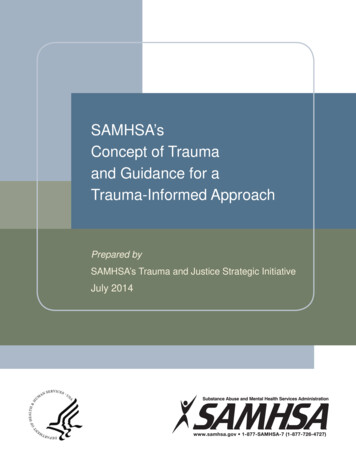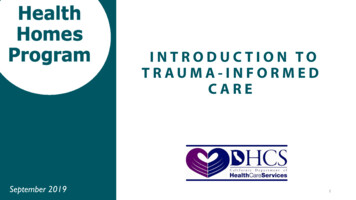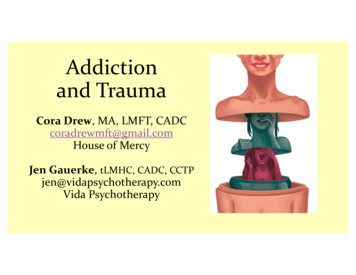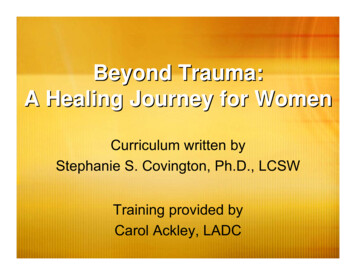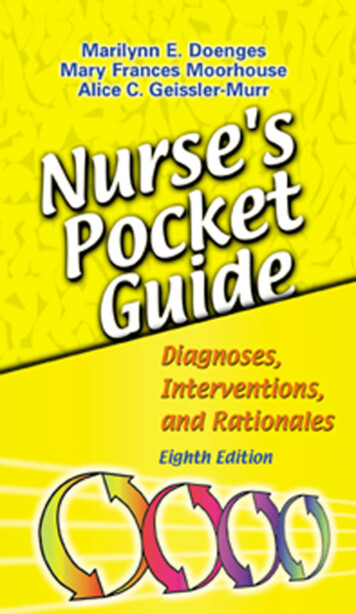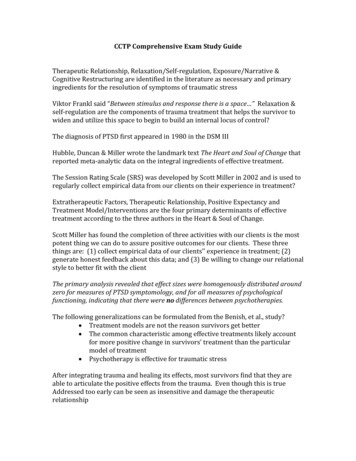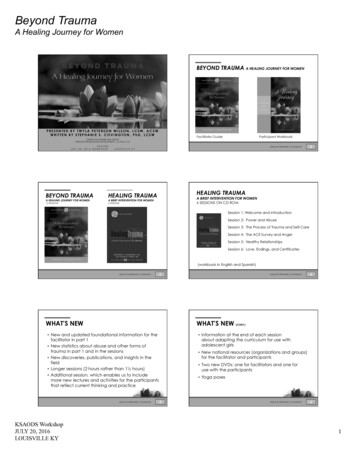
Transcription
Beyond TraumaA Healing Journey for WomenBEYOND TRAUMA A HEALING JOURNEY FOR WOMENPRESENTED BY TWYLA PETERSON WILSON, LCSW, ACSWWRITTEN BY STEPHANIE S. COVINGTON, PhD, LCSWFacilitator GuideCENTER FOR GENDER AND JUSTICEINSTITUTE FOR RELATIONAL DEVELOPMENT LA JOLLA, CAKSAODSJ U LY 2 0 , 2 0 1 6 W O R K S H O P 2016 BY STEPHANIE S. COVINGTONLOUISVILLE KYBEYOND TRAUMAHEALING TRAUMA12 SESSIONS6 SESSIONSA HEALING JOURNEY FOR WOMENParticipant Workbook2HEALING TRAUMAA BRIEF INTERVENTION FOR WOMEN6 SESSIONS ON CD-ROMA BRIEF INTERVENTION FOR WOMENSession 1: Welcome and IntroductionSession 2: Power and AbuseSession 3: The Process of Trauma and Self-CareSession 4: The ACE Survey and AngerSession 5: Healthy RelationshipsSession 6: Love, Endings, and Certificates(workbook in English and Spanish) 2016 BY STEPHANIE S. COVINGTON3WHAT’S NEWWHAT’S NEW New and updated foundational information for thefacilitator in part 1 New statistics about abuse and other forms oftrauma in part 1 and in the sessions New discoveries, publications, and insights in thefield Longer sessions (2 hours rather than 1½ hours) Additional session, which enables us to includemore new lectures and activities for the participantsthat reflect current thinking and practice 2016 BY STEPHANIE S. COVINGTONKSAODS WorkshopJULY 20, 2016LOUISVILLE KY 2016 BY STEPHANIE S. COVINGTON4(CONT.) Information at the end of each sessionabout adapting the curriculum for use withadolescent girls New national resources (organizations and groups)for the facilitator and participants Two new DVDs: one for facilitators and one foruse with the participants Yoga poses5 2016 BY STEPHANIE S. COVINGTON61
Beyond TraumaA Healing Journey for WomenPART 1:OVERVIEW OF TRAUMA AND THEBEYOND TRAUMA PROGRAMChapter 1: Background InformationChapter 2: Introduction to the ProgramPART 1:PART 2:OVERVIEW OF TRAUMA AND THEBEYOND TRAUMA PROGRAMSESSION OUTLINES 2016 BY STEPHANIE S. COVINGTON7CHAPTER 1: BACKGROUND INFORMATION 2016 BY STEPHANIE S. COVINGTON8CHAPTER 2: INTRODUCTION TO THE PROGRAM What Is Trauma? The Curriculum Women and Trauma Using the Facilitator Guide Understanding Trauma The Role of the Facilitator A Model for Women’s Recovery:Women’s Integrated Treatment (WIT) Suggestions for Conducting Group Sessions Working with Trauma 2016 BY STEPHANIE S. COVINGTON9 2016 BY STEPHANIE S. COVINGTON1011 2016 BY STEPHANIE S. COVINGTON12CHAPTER 1:BACKGROUND INFORMATION 2016 BY STEPHANIE S. COVINGTONKSAODS WorkshopJULY 20, 2016LOUISVILLE KY2
Beyond TraumaA Healing Journey for WomenLEVELS OF VIOLENCE ChildhoodAlthough the world is full of suffering,it is also full of the overcoming of it. Adolescence Adulthood Street (workplace and community) Helen Keller Consumer culture and media War Planet13 2016 BY STEPHANIE S. COVINGTON 2016 BY STEPHANIE S. COVINGTONTWO KINDS OF SUFFERINGDEFINITION OF TRAUMA NaturalThe diagnostic manual used by mental health Createdproviders defines trauma as14“exposure to actual or threatened death,serious injury, or sexual violence” 2016 BY STEPHANIE S. COVINGTONDEFINITION OF TRAUMA15(American Psychiatric Association 2013)DEFINITION OF TRAUMA(CONT.) 2016 BY STEPHANIE S. COVINGTON16(CONT.)The exposure must result from one or more ofThe exposure must result from 1 or more ofthe following scenarios in which the individualthe following scenarios, in which the individual learns that the traumatic event occurredto a close family member or close friend experiences firsthand repeated or extremeexposure to aversive details of the traumaticevent (not through media, pictures, television, or movies directly experiences the traumatic event witnesses the traumatic event in personunless work-related)(American Psychiatric Association 2013)KSAODS WorkshopJULY 20, 2016LOUISVILLE KY 2016 BY STEPHANIE S. COVINGTON17(American Psychiatric Association 2013) 2016 BY STEPHANIE S. COVINGTON183
Beyond TraumaA Healing Journey for WomenDEFINITION OF TRAUMADEFINITION OF TRAUMA(CONT.)The disturbance, regardless of its trigger,causes significant distress or impairment in theindividual’s(CONT.)Trauma occurs when an external threatoverwhelms a person’s internal and externalpositive coping resources. social interactions capacity to work other important areas of functioning(It is not the physiological result of another medical condition,medication, alcohol, or other drugs.)(American Psychiatric Association 2013) 2016 BY STEPHANIE S. COVINGTON19VIOLENCE AGAINST WOMEN 2016 BY STEPHANIE S. COVINGTONTRAUMAViolence against women is so pervasive thatthe United Nations has addressed anddefined violence against women as “any actof gender-based violence that results in, or islikely to result in, physical, sexual orpsychological harm or suffering to women,including threats of such acts, coercion orarbitrary deprivation of liberty, whetheroccurring in public or in private life.”(United Nations General Assembly 1993) 2016 BY STEPHANIE S. COVINGTON20Gender Differences21GENDER AND ABUSE 2016 BY STEPHANIE S. COVINGTONGENDER AND ABUSE As children, boys and girls suffer similar rates ofabuse22(CONT.) Adulthood– Man – combat or being a victim of crime– Girls - sexually abused– Woman – relationship; the person “I love you.”– Boys - emotional neglect or physical abuse. Transgender In adolescence, boys are at greater risk if they aregay, young men of color, or gang members.– High risk and rates of abuse– Young men - people who dislike or hate them.– Young women – relationships; from the person towhom she is saying, “I love you.” 2016 BY STEPHANIE S. COVINGTONKSAODS WorkshopJULY 20, 2016LOUISVILLE KY23 2016 BY STEPHANIE S. COVINGTON244
Beyond TraumaA Healing Journey for WomenTRAUMATIC EVENTSTRAUMATIC EVENTSTrauma can take many forms: Catastrophic injuries and illnessesEmotional, sexual, or physical abuseNeglectAbandonment (especially for small children)Extremely painful and frightening medicalprocedures 2016 BY STEPHANIE S. COVINGTONTRAUMATIC EVENTS(CONT.) Rape or assault Muggings Domestic violence Burglary Automobile accidents25 2016 BY STEPHANIE S. COVINGTONTRAUMATIC EVENTS(CONT.)26(CONT.) The unexpected/violent loss of a loved one(even of a pet) Immigration Natural disasters (hurricanes, floods,earthquakes, tornadoes, fires, volcanoes) Kidnapping Terrorism, such as September 11, 2001 Trafficking Witnessing violence, such as a parentharming another parent Torture Combat/war Intergenerational (cultural or historical)trauma 2016 BY STEPHANIE S. COVINGTON27HISTORICAL TRAUMA 2016 BY STEPHANIE S. COVINGTON28DEFINITION OF HISTORICAL TRAUMA Across generations“ the cumulative emotional andpsychological wounding spanninggenerations, which emanates from amassive group trauma.” Massive group trauma Examples include Native Americans,African Americans, Holocaust survivors,Japanese internment survivors 2016 BY STEPHANIE S. COVINGTONKSAODS WorkshopJULY 20, 2016LOUISVILLE KY29(Brave Heart 2005) 2016 BY STEPHANIE S. COVINGTON305
Beyond TraumaA Healing Journey for WomenINTERPERSONAL VIOLENCETRAUMA-INFORMED SERVICES(INTIMATE PARTNER VIOLENCE — IPV) Take the trauma into account. Avoid triggering trauma reactions.Of all these forms of trauma,women are at greater risk of interpersonalabuse than men. 2016 BY STEPHANIE S. COVINGTON Adjust the organization so that traumasurvivors can access and benefit fromservices.31CORE VALUES OFTRAUMA-INFORMED CARE(Harris and Fallot 2001) 2016 BY STEPHANIE S. COVINGTONCORE VALUES OF TRAUMAINFORMED ENVIRONMENT Safety (physical and emotional)Safety: TrustworthinessEnsuring physical andemotional safetyTrustworthiness:Maximizing trustworthiness,modeling openness,maintaining appropriateboundaries, and making tasksclearChoice:Emphasizing individualchoice and control Choice Collaboration Empowerment(Fallot and Harris 2008)32 2016 BY STEPHANIE S. COVINGTON33(Adapted from Fallot and Harris 2008) 2016 BY STEPHANIE S. COVINGTON34CORE VALUES OF TRAUMAINFORMED ENVIRONMENT(CONT.)Collaboration:Providing equality inparticipation, sharing power,and creating a sense ofbelongingEmpowerment:Striving for empowerment andskill-building(Adapted from Fallot and Harris 2008)KSAODS WorkshopJULY 20, 2016LOUISVILLE KY 2016 BY STEPHANIE S. COVINGTONBecoming Trauma InformedCreates a Culture Shift35 2016 BY STEPHANIE S. COVINGTON366
Beyond TraumaA Healing Journey for WomenA CULTURE SHIFT:PROCESS OF TRAUMASCOPE OF CHANGE IN A DISTRESSED SYSTEMTraumatic EventOverwhelms the physical and psychological coping skillsResponse to TraumaFight, flight, or freezeAltered state of consciousness, Body sensations, Numbing,Hypervigilance, Hyperarousal, Collapse Involves all aspects of program activities,setting, relationships, and atmosphere(more than implementing new services)Sensitized Nervous SystemChanges in the BrainBrain-Body Connection Involves all groups: administrators, supervisors,direct service staff, support staff, and consumers(more than service providers) Involves making trauma-informed changeinto a new routine, a new way of thinking andacting (more than new information)(Harris and Fallot 2001) 2016 BY STEPHANIE S. COVINGTONPROCESS OF TRAUMAPsychological and Physical DistressCurrent stressors, Reminders of trauma (triggers)Sensations, Images, Behavior, Affect (emotions), MemoryEmotional and/or Physical ResponsesRetreatHarmfulBehavior to SelfHarmfulBehavior to OthersPhysicalHealth IssuesIsolationDissociationDepressive disordersAnxiety disordersSubstance use disordersFeeding and eatingdisordersDeliberate self-harmSuicidal actionsAggressionViolenceRagesThreatsLung diseaseHeart diseaseAutoimmune disordersObesity37 2016 BY STEPHANIE S. COVINGTONPROCESS OF TRAUMA(CONT.)38(CONT.)Psychological and Physical DistressTraumatic EventCurrent stressors, Reminders of trauma (triggers)Sensations, Images, Behavior, Affect (emotions), MemoryOverwhelms the physical and psychological coping skillsEmotional and/or Physical ResponsesResponse to TraumaFight, flight, or freezeAltered state of consciousness, Body sensations, Numbing,Hypervigilance, Hyperarousal, CollapseSensitized Nervous SystemChanges in the BrainBrain-Body Connection 2016 BY STEPHANIE S. COVINGTONRetreatHarmfulBehavior toSelfHarmfulBehavior toOthersPhysicalHealth ety disordersSubstance usedisordersFeeding andeating disordersDeliberate selfharmSuicidal actionsAggressionViolenceRagesThreatsLung diseaseHeart diseaseAutoimmunedisordersObesity39TRAUMA 2016 BY STEPHANIE S. COVINGTONTRAUMA(CONT.) Variation in what trauma is Acute event: accident, assault Variation in response Chronic: ongoing abuse, poverty, racism 2016 BY STEPHANIE S. COVINGTONKSAODS WorkshopJULY 20, 2016LOUISVILLE KY4140 2016 BY STEPHANIE S. COVINGTON427
Beyond TraumaA Healing Journey for WomenTOXIC STRESSPRIMARY RESPONSES Stress of adversity is toxic to thedevelopment of the brain Emotions—dysregulation Important consideration with children Relationships—lack of connection and trust 2016 BY STEPHANIE S. COVINGTON Behavior—unmanageable43PRIMARY ISSUES (CHILDREN) 2016 BY STEPHANIE S. COVINGTON44ACE STUDY(ADVERSE CHILDHOOD EXPERIENCES) Attachment—relationships Regulation—feelings and behavior Collaboration between Competencies—learning– Centers for Disease Control and Prevention– Kaiser Permanente HMO in California Largest study ever 17,000 adult members participated 2016 BY STEPHANIE S. COVINGTONACE STUDY45 2016 BY STEPHANIE S. COVINGTONACE STUDY(CONT.)(CONT.)Before age 18:Growing up in a household with1.Recurrent and severe emotional abuse6.Both biological parents not being present2.Recurrent and severe physical abuse7.Your mother being treated violentlyContact sexual abuse8.An alcoholic or drug user4.Emotional neglect9.5.Physical neglectA family member who is mentally ill,chronically depressed, or attempting suicide3.4610. A family member being imprisoned(N 17,000) 2016 BY STEPHANIE S. COVINGTONKSAODS WorkshopJULY 20, 2016LOUISVILLE KY47 2016 BY STEPHANIE S. COVINGTON488
Beyond TraumaA Healing Journey for WomenACE STUDYHIGHER ACE SCORE(CONT.)CHRONIC HEALTH CONDITIONSResultsACEs still have a profound effect 50 years later,although now transformed from psychosocialexperience into organic disease, socialmalfunction, and mental illness. Smoking Alcoholism Injection of illegal drugs Obesity(Felitti 2002, 44-47)ACE STUDY 2016 BY STEPHANIE S. COVINGTON Liver disease Autoimmunediseases Skeletal fractures Lung cancer Sexually transmittedinfections Pulmonary disease HIV/AIDS49 2016 BY STEPHANIE S. COVINGTONACE STUDY(CONT.) 2016 BY STEPHANIE S. COVINGTON50(CONT.)“I see that you have Tell me how that has affected you later inyour life.”Women are 50% more likely than mento have a score of 5 or more.(Felitti and Anda 2010) Heart disease51WOMEN IN PRISON(Felitti and Anda 2010)WOMEN IN PRISONCHILDHOOD TRAUMATIC EVENTSLARGEST EFFECT—MENTAL HEALTH 2016 BY STEPHANIE S. COVINGTON52(CONT.)CHILDHOOD TRAUMATIC EVENTSLARGEST EFFECT—MENTAL HEALTH Psychotropic medication 980% increase in odds if exposed to 7 CTEs Mental health treatment Attempted suicide Traumatic stress(Messina and Grella 2006)KSAODS WorkshopJULY 20, 2016LOUISVILLE KY 2016 BY STEPHANIE S. COVINGTON53(Messina and Grella 2006) 2016 BY STEPHANIE S. COVINGTON549
Beyond TraumaA Healing Journey for WomenTRAUMA-SPECIFIC INTERVENTIONSServices designed specifically to address violence, trauma, and relatedsymptoms and reactionsTrauma Informed to facilitate recovery and healingTrauma Specific 2016 BY STEPHANIE S. COVINGTON55TRAUMA: STAGES OF RECOVERY 2016 BY STEPHANIE S. COVINGTONTRAUMA: STAGES OF RECOVERY(CONT.)SYNDROMESTAGE ONESTAGE TWOSTAGE THREESYNDROMESTAGE ONESTAGE TWOSTAGE tExplorationof tationComplicatedposttraumaticstress disorderStabilizationIntegration ofmemoriesDevelopmentof self, driveintegrationCombattraumaTrust, rationof trauma(Herman 1997) 2016 BY STEPHANIE S. COVINGTONTRAUMA: STAGES OF RECOVERY57(Herman 1997)RECOVERYSTAGE ONERECOVERYSTAGE TWORECOVERYSTAGE THREETherapeutictaskSafetyRemembranceand ent, psSTAGE ONESTAGE TWOSTAGE bilization,communication,cooperationMetabolism oftraumaResolution,integration,development ofpost-resolutioncoping skillsTraumaticdisordersSafetyRemembrance andmourningReconnectionKSAODS WorkshopJULY 20, 2016LOUISVILLE KY 2016 BY STEPHANIE S. COVINGTON 2016 BY STEPHANIE S. COVINGTON58TRAUMA: THREE GROUP MODELS(CONT.)SYNDROME(Herman 1997)5659(Herman 1997) 2016 BY STEPHANIE S. COVINGTON6010
Beyond TraumaA Healing Journey for WomenTRAUMA: THREE GROUP MODELSGROUPRECOVERYSTAGE ONERECOVERYSTAGE TWORECOVERYSTAGE BoundariesFlexible,inclusiveClosedStable, slowturnoverCohesionModerateVery highHigh(Herman 1997)TRAUMA: THREE GROUP MODELS(CONT.) 2016 BY STEPHANIE S. COVINGTONRECOVERYSTAGE ONERECOVERYSTAGE TWORECOVERYSTAGE THREEConflicttoleranceLowLowHighTime limitOpen-endedor repeatingFixed ucturedExampleTwelve StepprogramsSurvivor groupInterpersonalpsychotherapygroupGROUP61KEY ELEMENTS (STAFF AND CLIENTS)(CONT.)(Herman 1997) 2016 BY STEPHANIE S. COVINGTON62SECONDARY TRAUMATIC STRESS (STS) Compassion fatigue Learn what trauma/abuse is Understand typical responsesNo empathy—doesn’t happen Develop coping skillsCharles Figley “sudden” BurnoutBloom—conflict of values Vicarious traumatizationLaurie Pearlman “slow” 2016 BY STEPHANIE S. COVINGTON63DEFINITION OF RECOVERYKSAODS WorkshopJULY 20, 2016LOUISVILLE KY 2016 BY STEPHANIE S. COVINGTON64TRAUMA AND ADDICTIONThe definition of recovery has shiftedfrom a focus on what is deleted from one’slife (alcohol and other drugs, arrests forcriminal acts, hospitalizations) to what isadded to one’s life (the achievement ofhealth and happiness).(Miller and Delaney 2005) 2016 BY STEPHANIE S. COVINGTONThe women with more experiences oftrauma had more severe addiction issues.65(Johnson, Cottler, O’Leary, and Abdallah 2010) 2016 BY STEPHANIE S. COVINGTON6611
Beyond TraumaA Healing Journey for WomenABUSE AND SUBSTANCE USESEXUAL ABUSE AND SUBSTANCE USEAbuse within the first 5 years of lifeis significantly associated with substance usein girls as young as 12, through the teen years,and in the early 20s.(Lansford, Dodge, Pettit, and Bates 2010) 2016 BY STEPHANIE S. COVINGTON67SEXUAL ABUSE AND MENTAL HEALTH 2016 BY STEPHANIE S. COVINGTON69(American Psychiatric Association 2013) 2016 BY STEPHANIE S. COVINGTON70POSTTRAUMATIC STRESS DISORDER (PTSD) (CONT.) Arousal symptoms—angry outbursts, recklessand dangerous behavior, hypervigilance,difficulty sleepingKSAODS WorkshopJULY 20, 2016LOUISVILLE KY68 Avoidant symptoms—avoiding people,places, and situations that are triggers orreminders; disconnection Negative emotions and thoughts—blaming,excessive negativity, fear, anger, shame,diminished interests, feelings of isolation 2016 BY STEPHANIE S. COVINGTON 2016 BY STEPHANIE S. COVINGTON Intrusive symptoms—flashbacks, nightmares,intense or prolonged distressPOSTTRAUMATIC STRESS DISORDER (PTSD) (CONT.)(American Psychiatric Association 2013)(McFarlane et al. 2005)POSTTRAUMATIC STRESS DISORDER (PTSD)Women who have histories of sexual assaultcommonly experience multiple factors: 65% experience PTSD 51% experience depression 82% develop anxiety 49% become dependent on alcohol 61% use illicit substances 44% experience thoughts of suicide 19% attempt suicide(Campbell, Dworkin, and Cabral 2009)Women who experience more than 1 sexualassault are 3.5 times more likely to either startor increase the frequency of their substanceuse than women with only 1 assaultexperience.71Trauma seems to lead to brain changes ineveryone who is exposed. PTSD may notactually be abnormal or a “disorder” but thebrain’s natural reaction to events andexperiences that are abnormal.(Stark, Parsons, Van Hartevelt, et al. 2015) 2016 BY STEPHANIE S. COVINGTON7212
Beyond TraumaA Healing Journey for WomenTYPES OF ABUSETYPES OF ABUSE(CONT.) Sexual abuseStigmatization Physical abuseWomen and girls in criminal justice system Emotional abuseWomen and girls of color Domestic violenceWomen and girls in poverty Witnessing abuse/violenceLesbian, transgender, bisexual women and girls Self-inflicted violenceWomen and girls with mental health disorders Military sexual assault (MST) 2016 BY STEPHANIE S. COVINGTON73EFFECTS OF TRAUMA 2016 BY STEPHANIE S. COVINGTONEFFECTS OF TRAUMANeuroscience research shows that the onlyway we can help women who haveexperienced trauma change how they feel isby helping them to become aware of theirinner experiences and learnwhat is going on inside them. 2016 BY STEPHANIE S. COVINGTON74(CONT.)Most of our conscious brains are dedicatedto focusing on the outside world. Some ofthe activities in Beyond Trauma aredesigned to help women focus on the insideto identify and accept the emotionsembedded in their bodies.75 2016 BY STEPHANIE S. COVINGTONSEEDSSEEDSFive factors to promote healing of the brain:S – social connectivity76(CONT.)Being in connection and relationship with others. S – social connectivityE – exerciseThirty minutes a day can make a big difference. E – exerciseE – education E – educationLearn something new each day.D – diet D – dietThe food we eat either nourishes or starves our brain.S – sleep S – sleepOur brains and our bodies need to rest and regenerateeach day.(Arden 2014)KSAODS WorkshopJULY 20, 2016LOUISVILLE KY 2016 BY STEPHANIE S. COVINGTON77(Arden 2014) 2016 BY STEPHANIE S. COVINGTON7813
Beyond TraumaA Healing Journey for WomenEVOLVING TREATMENT APPROACHESGENDER-RESPONSIVE TREATMENT Creating an environment through– site selection– staff selection– program development– content and material that reflects an understanding of the realities ofthe lives of women and girls and addresses and responds to their strengthsand challenges.(Grella 2008) 2016 BY STEPHANIE S. COVINGTON79WHAT IS AGENDER-RESPONSIVE APPROACH? Women-only (WO) treatment compared tomixed-gender (MG) WO increased odds of successful outcomeby 49%81 2016 BY STEPHANIE S. COVINGTON82The theories related to gender and addiction(and any other relevant treatment services)that create the framework of thought forprogram development. This is the knowledgebase that creates the foundation upon whichthe program is developed. the gender-responsive definition andguiding principles a theoretical foundation interventions/strategies that aremultidimensionalKSAODS WorkshopJULY 20, 2016LOUISVILLE KY(Evans, Levin, Li, and Hser 2013)THEORETICAL FOUNDATIONThis model is holistic, integrated, and basedon 2016 BY STEPHANIE S. COVINGTON80LONG-TERM OUTCOMES (10-YEAR FOLLOW-UP)WOMEN’S INTEGRATED TREATMENT (WIT)(Covington 2007) 2016 BY STEPHANIE S. COVINGTONWOMEN-ONLY TREATMENTLess about differences between males andfemales and more about using research ongirls and women (boys and men) to guidewhat we do. 2016 BY STEPHANIE S. COVINGTON(Covington 2002)83 2016 BY STEPHANIE S. COVINGTON8414
Beyond TraumaA Healing Journey for WomenBEYOND TRAUMAWOMEN’S INTEGRATED TREATMENT (WIT)THEORETICAL FOUNDATIONA HEALING JOURNEY FOR WOMENTheory of AddictionHolistic health modelChronic neglect of self in favor of something orsomeone elseTrauma Theory– Sandra Bloom, MD– Judith Herman, MD– Peter Levine, PhD– Daniel Siegel, MDIntegrates cognitive-behavioral, expressivearts, guided imagery, and relational therapy.Theory of Women’s Psychological DevelopmentRelational-cultural model (Stone Center)Theory of TraumaThree-Stage Model (Herman)Upward Spiral—A Transformational Model (Covington) 2016 BY STEPHANIE S. COVINGTON85TREATMENT STRATEGIES 2016 BY STEPHANIE S. COVINGTONTREATMENT STRATEGIES86(CONT.) Cognitive-behavioralThe approaches used in the program thatcreate the therapeutic process. These arethe ways in which theory is operationalized(how theory is applied). Guided imagery Relational therapy Mindfulness Eye movement desensitization and reprocessing(EMDR) Emotional Freedom Techniques (EFT) Expressive arts Mind-body (yoga) 2016 BY STEPHANIE S. COVINGTON87BEYOND TRAUMAAND HEALING TRAUMA THEMES Safety Empowerment Mind-bodyconnection Connection(Aloneness) Woman-centered Substance abuse 2016 BY STEPHANIE S. COVINGTON88EVIDENCE-BASED Normal reactions(Shame)KSAODS WorkshopJULY 20, 2016LOUISVILLE KY 2016 BY STEPHANIE S. COVINGTON89Researched in Residential treatment Women’s prison Drug courtListed on NREPP and CEBC 2016 BY STEPHANIE S. COVINGTON9015
Beyond TraumaA Healing Journey for WomenPRISON STUDY (NIDA FUNDED)CLIENT ASSESSMENT SCORES IMPROVEAFTER COMPLETION OF HWR AND BTMean Score 45 DaysHWRTOTAL 40-44BT Randomized control group Gender-responsive vs. Therapeuticcommunity Significant differences– Greater reduction of drug use– More likely to complete treatment– Remained longer in aftercare– Less recidivism (re-incarcerated) at 12 months(p .05 or less)Source: KIVA Program records – BDI & TSC Assessment, August 31, 2004 –October 13, 2006. Keaton, Curtis, and Burke (2006) SANDAG(p .05) S. Covington, 201591 2016 BY STEPHANIE S. COVINGTON92HEALING TRAUMADRUG STUDY (NIDA FUNDED)A BRIEF INTERVENTION FOR WOMEN6 SESSIONS ON CD-ROM Four sites in San Diego County Randomized control group Results– Fewer sanctions– Longer in treatment– Reduced PTSD symptoms– Judge notices differencesPRE AND POST TREATMENT FigureCHANGESIN SYMPTOMS ect,DEPRESSIONAND POSTTRAUMATIC STRESSOctober1,2012throughSeptember30,2013(N 53)2725Score2321CESD (t 4.79, df 52, p .000)PCL (t 2.96, df 52, p .005)191715Pre-Test 2016 BY STEPHANIE S. COVINGTON93Post-Test(September 2013 Annual Report: The Interpersonal Violence Project,Josephine M. Hawke, PhD) 2016 BY STEPHANIE S. COVINGTON94CHAPTER 2: INTRODUCTION TO THE PROGRAM The Curriculum Using the Facilitator Guide The Role of the Facilitator Suggestions for Conducting Group SessionsCHAPTER 2:INTRODUCTION TO THE PROGRAM 2016 BY STEPHANIE S. COVINGTONKSAODS WorkshopJULY 20, 2016LOUISVILLE KY95 2016 BY STEPHANIE S. COVINGTON9616
Beyond TraumaA Healing Journey for WomenWHAT MAKES A GOOD FACILITATOR?WHAT MAKES A GOOD FACILITATOR? (CONT.)The following qualities in a facilitator will helpto ensure a positive group experience: Healthy boundaries, respects confidentiality Trustworthy Committed to and interested in women’sissues Credible Multicultural sensitivity and responsiveness Available Reliable, consistent Appropriate gender—a female shouldfacilitate the all-female groups Hopeful Prepares ahead of time for each session Warm, compassionate Emotionally mature 2016 BY STEPHANIE S. COVINGTON97 2016 BY STEPHANIE S. COVINGTON98WHEN IS SOMEONE READYTO EXPLORE TRAUMA?WHAT MAKES A GOOD FACILITATOR? (CONT.) If a trauma survivor, she needs to feelconfident that she is at a place in her ownrecovery that will allow for healthy andpositive outcomes for herself and thewomen in the group She is able to use some safe coping skills. She has no major current crises or instability(e.g., just became homeless). Content expertise, if possible She is willing to do this type of work. Skills as a facilitator She can reach out for help when in danger. She is not using substances to such a severedegree that emotionally upsetting workmay increase her use. 2016 BY STEPHANIE S. COVINGTON99WHEN IS SOMEONE READYTO EXPLORE TRAUMA? 2016 BY STEPHANIE S. COVINGTON100BEYOND TRAUMA(CONT.) Her suicidality has been evaluated andtaken into account.Each of the 12 sessions addresses how toadapt the session for adolescent girls. She is in an ongoing system of care that isstable and consistent, with no immediateplanned changes (e.g., discharge frominpatient unit or residential program). 2016 BY STEPHANIE S. COVINGTONKSAODS WorkshopJULY 20, 2016LOUISVILLE KY101 2016 BY STEPHANIE S. COVINGTON10217
Beyond TraumaA Healing Journey for WomenGIRLS’ COMPARISON STUDYGIRLS’ COMPARISON STUDYSexually abused girls suffer more often fromthe following:(CONT.) Dropping out of high school at a higher rate Depression Major illnesses Dissociative symptoms Being diagnosed with a host of differentpsychiatric labels Troubled sexual development Obesity Self-harm(Trickett, Noll, and Putnam 2011) 2016 BY STEPHANIE S. COVINGTON103HEALING FROM TRAUMA The woman is able to bear feelings associatedwith traumatic memories. The woman has authority over her memories(that is, her memories don’t limit what she does;she chooses what to do, instead of beingimmobilized in some areas). The memory of trauma is linked with feelings. 2016 BY STEPHANIE S. COVINGTON105RESILIENCE(CONT.)(Harvey 1996, 2007) 2016 BY STEPHANIE S. COVINGTON106(CONT.)Although some people are more naturallyresilient, a way to develop resilience is inworking through the emotions and effects ofstress and painful events. Resilience developsas people develop better coping skills. It alsocomes from supportive, caring relationshipswith others.The word resilience stems from a Latin wordmeaning leap back. 2016 BY STEPHANIE S. COVINGTON104 Damaged self-esteem is restored (for example,a rape survivor realizes that the rape did notoccur because she was a “bad” woman). Important relationships have beenreestablished. The woman has reconstructed a system ofmeaning and belief that encompasses the storyof the trauma (for instance, she understandsthat the rape was not caused by her and thatsome men use power and control to get whatthey want).RESILIENCEResilience is the ability to adapt well in theface of difficult life events. It is the ability torecover from or adjust easily to misfortune orchange.KSAODS WorkshopJULY 20, 2016LOUISVILLE KY 2016 BY STEPHANIE S. COVINGTONHEALING FROM TRAUMA The physical symptoms of PTSD are withinmanageable limits.(Harvey 1996, 2007)(Trickett, Noll, and Putnam 2011)107 2016 BY STEPHANIE S. COVINGTON10818
Beyond TraumaA Healing Journey for WomenPOSTTRAUMATIC GROWTHPOSTTRAUMATIC GROWTH Personal strengthVulnerability è powerlessness can paradoxicallyboost self-confidence RelationshipsBonding on a deeper level after tragedy Greater life appreciationCan shift perspective to focus on gratitude and joy BeliefsMay change or be reinforced by grief New possibilitiesPerceive new opportunities and pursue them Positive changes from a major life crisis Searching for good in the terrible Beyond resilience Catalyst for higher level of functioning(Calhoun and Tedeshchi 1999, 2013) 2016 BY STEPHANIE S. COVINGTON(CONT.)109(Calhoun and Tedeshchi 1999, 2013) 2016 BY STEPHANIE S. COVINGTONTraining GroupTRAINING110Therapy GroupThe focus is on Events across the country Learning as a group Individual growth Onsite events Using the group forexperimental learningby means of activities Using the group torecreate family-of-origindynamics Having support fromoutside the group(for individual issues) Using the group forsupport for individualissues Sequential learning Process Staff participating in program materials 2016 BY STEPHANIE S. COVINGTON111 2016 BY STEPHANIE S. COVINGTON112BEYOND TRAUMAModule A Violence, Abuse, and TraumaModule BThe Impact of Trauma onWomen’s LivesModule C Healing from TraumaPART 2:SESSION OUTLINES 2016 BY STEPHANIE S. COVINGTONKSAODS WorkshopJULY 20, 2016LOUISVILLE KY113 2016 BY STEPHANIE S. COVINGTON11419
Beyond TraumaA Healing Journey for WomenFORMAT FOR ALL SESSIONSBEYOND TRAUMA MODULE A:VIOLENCE, ABUSE, AND TRAUMA Quiet time—“settling” Check-in(11 activities) Review of between-sessions activitySession 1 Introduct
Beyond Trauma A Healing Journey for Women KSAODS Workshop JULY 20, 2016 LOUISVILLE KY 5 TRAUMATIC EVENTS Trauma can take many forms: Emotional, sexual, or physical abuse




